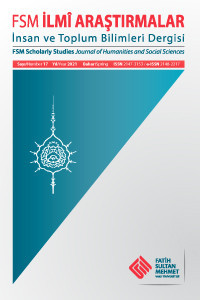Menâúıb-ı èAli Es-Semarúandì’de -mIş eki
-mIş eki, Türk dilinin tarihî dönemlerinde çeşitli fonksiyonlarda kullanılmıştır. Ek,
genellikle dil uyumuna uygun olarak kullanıldığı halde dudak uyumuna girmesi çok geç
dönemlerde gerçekleşmiştir. Hatta dudak uyumuna en geç giren eklerden biri olduğu da
söylenebilir. Bu sebeple ekin kullanımı hem eserin nüshalarının tarihlendirilmesi hem de
benzer morfolojik şekillerin tarihî süreçteki gelişmeleriyle ilgili önemli bir bilgi kaynağı
durumundadır. Üzerinde çalışılan Menâúıb-ı èAli Es-Semerúandì adlı metin 17. yüzyılda
istinsah edilmiştir ve söz konusu ekle ilgili önemli veriler barındırmaktadır. Bu alanda
başka çalışmalar yapılmış olsa da bu çalışma dudak uyumu konusunu ele alacak çalışmalara
kaynaklık edecek nitelikte olacaktır. Üzerinde çalışılan eserde -mIş eki, yuvarlak
tabanlı fiillerden sonra hem düz dar hem de dudak uyumuna girmiş şekliyle yuvarlak
olarak tespit edildiğinden ekin bütünüyle dudak uyumuna girmediği söylenebilir. Eserdeki
bu durum ekin dudak uyumuna girme sürecinde olduğunu göstermektedir. Çalışmada
”Menâúıb-ı èAli Es-Semerúandì” adlı eserde geçen -mIş eki almış fiiller incelenerek
konu ile ilgili sayısal veriler ortaya konacaktır.
The -miş suffix in Menâúib-i èAli Es-Semarúandi
The -miş suffix has been used in various functions in the historical periods of the
Turkish language.
Although the suffix is generally used in accordance with language harmony, its inclusion
in labial harmony was very late. It can even be claimed that it is one of the latest
suffixes included in labial harmony.
Therefore, the use of the suffix is an important source of information about both the
dating of the copies of the work and the development of similar morphological figures in
the historical process. The work named Menâúib-i èAli Es-Semerúandi, which is being
studied, was copied in the 17th century and contains important data about the said suffix.
Although other studies have been conducted in this field, this study will be a source
for studies on labial harmony. Since the -miş suffix is found to be round as included
in both unrounded narrow vowel and labial harmony after round-based verbs, it can be
claimed in the work studied that the suffix is not completely included in labial harmony.
This situation in the work shows that the suffix is in the process of being included in
labial harmony. In the study, the verbs with the -miş suffix in the work “Menâúib-i èAli
Es-Semerúandi” will be examined and numerical data on the subject will be revealed.
